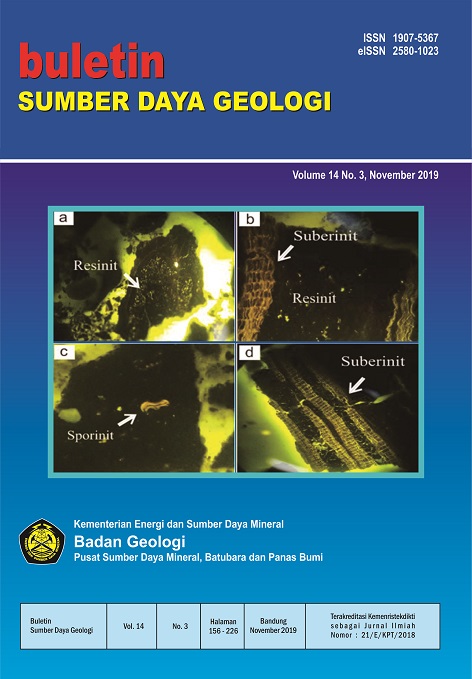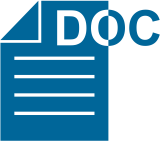PENERAPAN KOREKSI TOPOGRAFI PADA DATA MAGNETOTELLURIK DAN ANALISIS DATA GAYA BERAT DALAM INTERPRETASI DAERAH PANAS BUMI PANTAR, KABUPATEN ALOR, PROVINSI NUSA TENGGARA TIMUR
Abstract
Pantar berada pada lingkungan vulkanik Kuarter yang memiliki potensi panas bumi yang diindikasikan dengan adanya manifestasi panas bumi berupa fumarola, solfatara, tanah panas dan air panas. Survei geofisika magnetotelurik (MT) dan gaya berat dilakukan untuk mengklarifikasi sistem panas bumi di daerah ini. Teknik pemodelan data MT menggunakan inversi 3 dimensi (3-D) dengan dan tanpa koreksi topografi untuk optimalisasi hasil. Pemisahan anomali Bouguer pada metode gaya berat dilakukan dengan teknik trend surface analysis dan upward continuation. Hasil pemodelan MT dan gaya berat akan dikombinasikan untuk menginterpretasi sistem panas bumi. Penerapan koreksi topografi pada inversi 3D data MT yang dikombinasikan dengan metode gaya berat memberikan hasil yang lebih optimal. Kedua hasil metode tersebut secara jelas menunjukkan keberadaan lapisan penudung, zona reservoir dan sumber panas. Lapisan bertahanan jenis rendah yang diinterpretasikan sebagai lapisan penudung termodelkan di sekitar Gunung Beang sampai dengan kedalaman 750 meter. Lapisan bertahanan jenis medium yang diinterpretasikan sebagai zona reservoir dimodelkan mulai kedalaman 750-1000 meter. Zona anomali tinggi yang termodelkan pada kedua metode mempertegas adanya tubuh vulkanik muda yang diinterpretasikan sebagai sumber panas sistem panas bumi.
Downloads
References
Arnason, K. (2015). The Static Shift Problem in MT Soundings. Word Geothermal Congress. Melbourne: 2015.
Chave, A. D., & Weidelt, P. (2012). The Theoritical Basis for Electromagnetic Induction. Dalam A. D. Chave, & A. G. Jones, The Magnetotelluric Method (hal. 19-44). Cambridge: Cambridge University Press.
Dhaoui, M., & Gabtni, H. (2014). Depth to basement analysis from gravity field over the Guelb Ahmer horst (Ghadames petroleum province, Southern Tunisia, North Africa). IOSR Journal of Applied Geology and Geophysics (IOSR-JAGG) vol 2 Issue 5, 122-127.
Hadi, M., & Kusnadi, D. (2015). Survei Geologi dan Geokimia Daerah Panas Bumi Pantar, Kabupaten Alor, Nusa Tenggara Timur. Bandung: Pusat Sumber Daya Geologi.
Ivan, M. (1986). On The Upward Continuation of Potential Field Data Between Irregular Surfaces. Geophysical Prospecting, 735-742.
Nam, M., Kim, H., Song, Y., Lee, T., & Suh, J. (2008). Three-dimensional topography corrections of magnetotelluric data. Geophys. J. Int.
Noya, Y., & Koesoemadinata. (1991). Peta Geologi Regional Lembar Pantar dan Wetar. Bandung: Pusat Penelitian dan Pengembangan Geologi.
Obasi, A., Onwuemesi, A., & Romanus, O. (2016). An Enhanced Trend Surface Analysis Equation for Regional-Residual Separation of Gravity Data. Journal of Applied Geophysics 135, 90-99.
Siripunvaraporn, W., Egbert, G., Lenbury, Y., & Uyeshima, M. (2005). Three-dimensional magnetotelluric inversion: data-space method. Physics of The Earth And Planetary Interiors, 3-14.
Sugianto, A., Takodama, I., & Rahadinata, T. (2017). Identifikasi Struktur Sistem Panas Bumi Pantar Berdasarkan Analisis Gradien Horizontal dan Pemodelan 3D Data Gaya Berat. Buletin Sumber Daya Geologi Vol.12 no.2, 135-143.
Copyright (c) 2019 Buletin Sumber Daya Geologi

This work is licensed under a Creative Commons Attribution-NonCommercial-ShareAlike 4.0 International License.
Authors whose manuscripts are published agree to the following terms:
The publication rights of all journal manuscript materials published on the Buletin Sumber Daya Geologi website are held by the editorial board with the knowledge of the author (moral rights remain with the manuscript’s author).
The formal legal provisions for access to digital articles in this electronic journal are subject to the terms of the Creative Commons Attribution-ShareAlike (CC BY-SA) license. This means that Buletin Sumber Daya Geologi has the right to store, convert media/formats, manage in the form of a database, maintain, and publish the article without requesting permission from the author, as long as the author’s name is cited as the copyright holder.
Manuscripts published in both print and electronic formats are open access for educational, research, investigative, and library purposes. Beyond these purposes, the editorial board is not responsible for any violations of copyright law.















